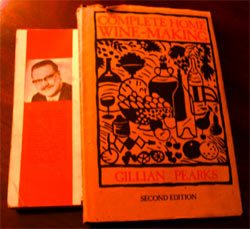Book review: Two good books for winemaking by C J J Berry and Gillian Pearks
Posted by Fiona Nevile in Reviews, Wine | 3 comments Back in the seventies, when buying a bottle of wine was an expensive treat, the author C. J. J. Berry shot to fame with his series of amateur winemaking books. This is the rather smooth looking character on the left. He cashed in on the great home winemaking boom of the sixties and seventies.
Back in the seventies, when buying a bottle of wine was an expensive treat, the author C. J. J. Berry shot to fame with his series of amateur winemaking books. This is the rather smooth looking character on the left. He cashed in on the great home winemaking boom of the sixties and seventies.
As glugable wine began to fill supermarket shelves, the home winemaking craze declined and you could often find his books in charity shops. Now that country winemaking is enjoying a small renaissance his books are becoming sought after again. The best of his tomes First Steps in Winemaking, has everything you need to know from selecting equipment to an extensive list of winemaking recipes. It even advises the ultra enthusiastic on how to organise a wine competition.
The recipes are grouped in monthly sections, so whenever you feel the irrepressible urge to make wine there is a good selection of seasonal recipes to choose from. The book is well written and packed with tips and useful information. It didn’t surprise me when I heard that Berry had been a newspaper editor. My copy, from 1980, lives in a pile of books beside our bed, between Tove Jansson’s Finn Family Moomintroll and The Essential Rumi
. All great books to while away a sleepless night.
The other book that I have is a small hardback Complete Home Winemaking by Gillian Pearks first published in 1962. This beautiful book is a much simpler animal than those in the C. J. J. Berry stable. It has all the essential information, useful tips and a calm clear style. Her recipes work well and include a range of liqueurs. If you ever find a copy of this book, snap it up and treasure it. Ours lives in the kitchen as this is my favourite winemaking companion and has become a true friend.
Update March 2007. Discovering Country Winemaking by Daphne More. This is a great winemaking book that I use a lot. Daphne More tries to avoid using chemicals and ofers sound advice. Worth adding to any winemaking library.
Leave a reply





I have been using ‘1st steps in wine making for some 40 years now, and never had one go wrong. Berry also wrote a book called Wine making with canned and dried fruit. I have never seen this, either here in the US or in England where i started. where do you think I might find a copy of this book?
I make quite a lot of Blueberry wine every year now. I crush and press the fruit, like a grape, and do not ferment on the skins. I use 75% juice. This makes a light Rose wine, light in colour not strength however. It is very good.
got my new fruit press going at the weekend. managed to press enough apples to make about 5gallons of juice which is now bubbling away merrily in an old water cooler bottle in the kitchen.
those water bottles are perfect; they’re clean and transparent, with just the right sized opening for a plug of cotton wool or bubbler.
the juice was made with a combination of four or five different apple varieties, some windfalls, some scrounged from a neighbour’s trees (swapped for the promise of a flaggon of the finished product!) before i added the yeast i put about 5pts into old plastic milk bottles and froze it for ron, later-ron.
so, 5 gals of cider on the go, 5pts of juice in the freezer and new friends to share a neighbouly drink with come the depths of winter…a good weekend.
how was country wine made before cjj berry etc wrote their books? common sense and collective, shared experience and knowledge. i remember how, years ago, when beginning to make my own wine, following cjj’s book i made gallons of wine, some turned out o.k., some went down the sink.. the most important thing was to make sure everything was ‘scrupulously clean’. however, even by doing this, some of my wine was not much cop because the ingredients used weren’t right. i soon gathered that it was best to stick to ingredients which ‘worked’. since then i’ve used only hedgerow and orchard fruits and made sure i’ve known the initial fruit sugar content of whatever has been used (a good summer makes good sugar content). for this a hydrometer is vital. acidity etc are also important. another important thing for me, is to avoid adding chemicals as much as possible. they always seem to leave a taint to wine, even campden tablets. be patient, wine always stops fermenting on its own. now i’ve got a fruit press and am a ‘beginner’ cider maker so will be using books to help me along initially, but i know now that ‘doing it’ will be the best teacher. p.s. the best wine i ever ‘made’ was a two pint cider flaggon full, made from the collected dregs of a mix of unknown homemade wines used in cooking and put in the back of a kitchen cupboard and discovered by good fortune, two or three years later. patience is a virtue, but chance is often a finer thing!.